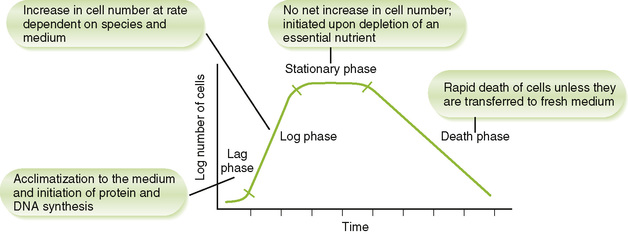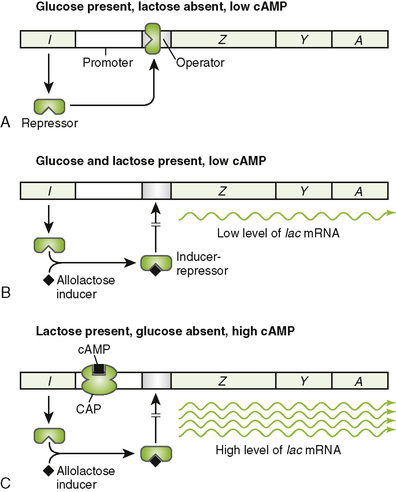Bacterial Growth, Genetics, and Virulence
I Proliferation of Bacterial Cells
• When placed in a new medium, bacteria exhibit a typical pattern of growth and multiplication marked by four phases (Fig. 7-1).
• Different bacteria require different nutrients for growth in the body and in culture.
• Characteristic nutrient requirements and metabolic products can be used to identify bacteria.
• Bacteria divide by binary fission, a simpler process than mitotic division of eukaryotic cells.
1. Chromosome duplication is initiated at a specific sequence (replication origin) in the DNA.
• If nutrients are available, synthesis of new chromosome begins before previous chromosome synthesis is completed. Once duplication is initiated, the process is completed even when culture conditions (e.g., starvation) are detrimental to the cell.
2. Synthesis of new membrane and cell wall in the center of the cell forms a septum that eventually divides the cytoplasm into two daughter cells, each containing a complete chromosome.
D Bacterial spores (endospores)
• Spores, formed by some gram-positive bacteria, represent a dormant state that is resistant to heat, drying, and chemicals.
1. Spore formation, a variant type of cell division, is induced by depletion of essential nutrients needed for normal growth.
• Antibiotics and toxins are often produced during sporogenesis, before release of the spore from the bacterial cell.
2. Germination of spores into vegetative cells is initiated by damage to the spore coat by trauma, water, or aging and requires specific nutrients.
• Important definitions are given in Table 7-1.
TABLE 7-1
Bacterial Genetics Terminology
| Term | Definition |
| Allele | A particular example of a gene. Each variant of a given gene is a different allele of that gene. Genes that are represented by multiple alleles in a population are said to be polymorphic. |
| Cistron | Region of DNA that codes for a single protein; a complementation unit |
| Operator | Nucleotide sequence, located between the promoter and first structural gene of an operon, that binds a repressor protein |
| Operon | Bacterial transcription unit comprising a promoter, operator, and one or more structural genes |
| Plasmid | Small extrachromosomal DNA molecule capable of autonomous replication in bacteria |
| Promoter | Nucleotide sequence in an operon that is recognized by RNA polymerase |
| Replicon | Replication unit, consisting of a replication origin, a replication terminus, and the intervening coding sequence |
1. Single, double-stranded, circular molecule of DNA, containing about 5 million base pairs (or 5000 kilobase pairs)
2. Operons provide coordinated control of protein-coding (structural) genes. A bacterial chromosome contains many operons.
• The enzymes in many bacterial metabolic pathways are encoded by polycistronic operons, which contain multiple structural genes.
• All the genes in a polycistronic operon are transcribed as a unit, producing a single messenger RNA (mRNA) that is translated into multiple proteins.
• Transcription of the lac operon and many other operons is controlled by presence or absence of metabolites to meet the needs of the cell (Fig. 7-2).
• DNA sequences (“jumping genes”) that can move from one position to another in a bacterial chromosome or between different molecules of DNA. These elements lack a replication origin.
a. Simple transposons (insertion sequences) encode only the proteins needed to move.
b. Complex transposons carry other genes (e.g., antibiotic-resistance genes).
• Pathogenicity islands are large transposons that contain all the genes needed for a pathogenic mechanism. They may contain several operons.









